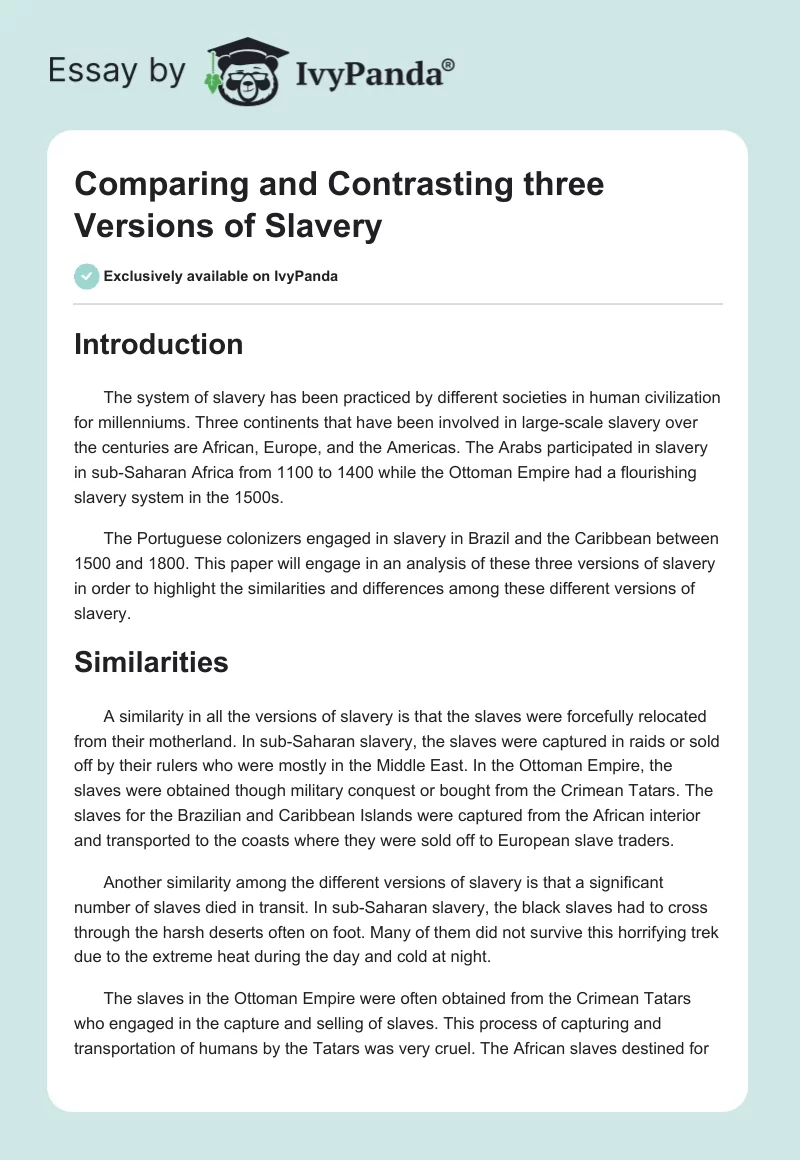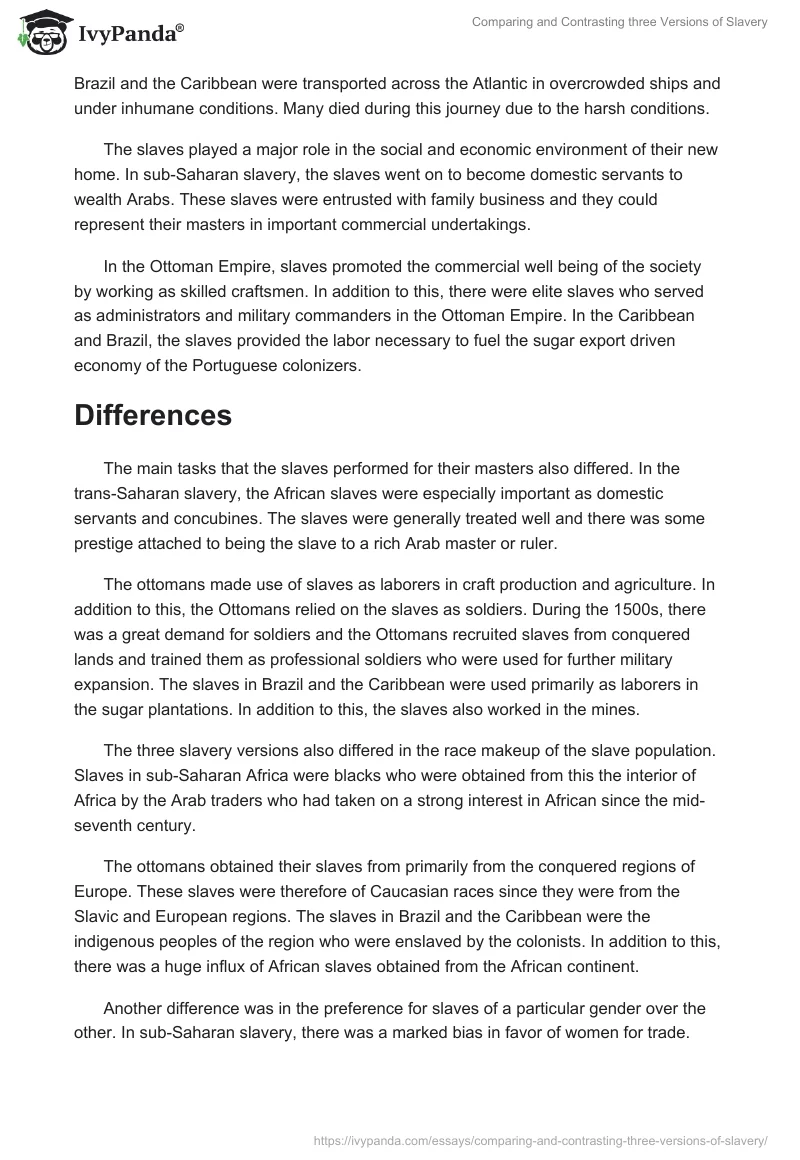Introduction
The system of slavery has been practiced by different societies in human civilization for millenniums. Three continents that have been involved in large-scale slavery over the centuries are African, Europe, and the Americas. The Arabs participated in slavery in sub-Saharan Africa from 1100 to 1400 while the Ottoman Empire had a flourishing slavery system in the 1500s.
The Portuguese colonizers engaged in slavery in Brazil and the Caribbean between 1500 and 1800. This paper will engage in an analysis of these three versions of slavery in order to highlight the similarities and differences among these different versions of slavery.
Similarities
A similarity in all the versions of slavery is that the slaves were forcefully relocated from their motherland. In sub-Saharan slavery, the slaves were captured in raids or sold off by their rulers who were mostly in the Middle East. In the Ottoman Empire, the slaves were obtained though military conquest or bought from the Crimean Tatars. The slaves for the Brazilian and Caribbean Islands were captured from the African interior and transported to the coasts where they were sold off to European slave traders.
Another similarity among the different versions of slavery is that a significant number of slaves died in transit. In sub-Saharan slavery, the black slaves had to cross through the harsh deserts often on foot. Many of them did not survive this horrifying trek due to the extreme heat during the day and cold at night.
The slaves in the Ottoman Empire were often obtained from the Crimean Tatars who engaged in the capture and selling of slaves. This process of capturing and transportation of humans by the Tatars was very cruel. The African slaves destined for Brazil and the Caribbean were transported across the Atlantic in overcrowded ships and under inhumane conditions. Many died during this journey due to the harsh conditions.
The slaves played a major role in the social and economic environment of their new home. In sub-Saharan slavery, the slaves went on to become domestic servants to wealth Arabs. These slaves were entrusted with family business and they could represent their masters in important commercial undertakings.
In the Ottoman Empire, slaves promoted the commercial well being of the society by working as skilled craftsmen. In addition to this, there were elite slaves who served as administrators and military commanders in the Ottoman Empire. In the Caribbean and Brazil, the slaves provided the labor necessary to fuel the sugar export driven economy of the Portuguese colonizers.
Differences
The main tasks that the slaves performed for their masters also differed. In the trans-Saharan slavery, the African slaves were especially important as domestic servants and concubines. The slaves were generally treated well and there was some prestige attached to being the slave to a rich Arab master or ruler.
The ottomans made use of slaves as laborers in craft production and agriculture. In addition to this, the Ottomans relied on the slaves as soldiers. During the 1500s, there was a great demand for soldiers and the Ottomans recruited slaves from conquered lands and trained them as professional soldiers who were used for further military expansion. The slaves in Brazil and the Caribbean were used primarily as laborers in the sugar plantations. In addition to this, the slaves also worked in the mines.
The three slavery versions also differed in the race makeup of the slave population. Slaves in sub-Saharan Africa were blacks who were obtained from this the interior of Africa by the Arab traders who had taken on a strong interest in African since the mid-seventh century.
The ottomans obtained their slaves from primarily from the conquered regions of Europe. These slaves were therefore of Caucasian races since they were from the Slavic and European regions. The slaves in Brazil and the Caribbean were the indigenous peoples of the region who were enslaved by the colonists. In addition to this, there was a huge influx of African slaves obtained from the African continent.
Another difference was in the preference for slaves of a particular gender over the other. In sub-Saharan slavery, there was a marked bias in favor of women for trade. This preference for women was because slaves were predominantly used as servants and concubines for the Arabs.
The Ottomans valued both male and female slaves. Men were preferred since there was a high demand for soldiers and skilled craftsmen. Women were also valued since there was a great demand for domestic servants in the Empire. Brazil and the Caribbean preferred male slaves who could work in the sugar plantations and mines.
The method of attaining slaves also differed among the three cases. In sub-Saharan Africa, slaves were obtained primarily though raids to villages or as tributes offered by some rules to the Arabs in order to avoid being attacked. In the Ottoman Empire, slaves were primarily obtained though military engagements.
Slaves were obtained from the lands that the Ottoman military had conquered. Communities were forced to give up their children as slaves to the conquering ottoman armies. Slaves for the plantations and mines in Brazil and the Caribbean were bought from the slave markets in Africa. The European bought these slaves from Arabs and Africans who ventured inland to capture the slaves.
Conclusion
This paper set out to highlight the similarities and differences in three different versions of slaveries. It has noted that the different versions of slavery were similar in that they led to a displacement of the slaves from their homeland and they involved cruel means of transporting slaves.
In addition to this, the slaves contributed to the economic prosperity of their masters. The major differences included the major activities that the slaves were used for, the race make up of the slaves, the gender preference of the slaves, and the means of obtaining the slaves.


